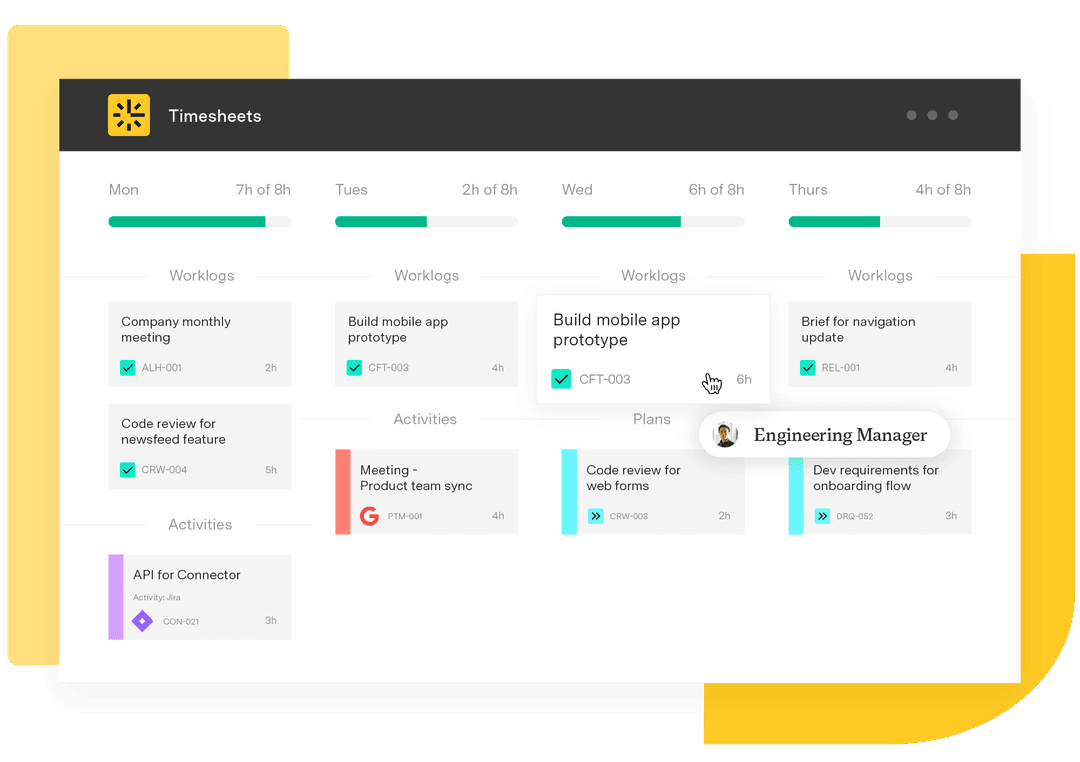A guide to overcoming Parkinson’s Law at work
Tempo Team
If you’ve ever had weeks to finish a small project, you know that the allotted time can fill up fast. Maybe you dive deep into what font to use for the presentation, or spend extra time getting feedback on your work – even though you probably could have finished the project in a day or two. This is Parkinson’s Law in action.
The Parkinson’s Law effect can be a huge hit to your productivity. While setting deadlines is one way to fight it, that alone often won’t solve the problem. Instead, understanding why Parkinson’s Law happens and restructuring the way you work can help you regain focus and accomplish more in less time.
What is Parkinson’s Law?
According to Parkinson’s Law, work expands to fill the time available for its completion.
First coined by Cyril Northcote Parkinson in a 1955 essay for The Economist, this observation came from his study of bureaucracies. He noticed that as organizations grew, tasks seemed to take longer – not because they were more complex, but because people adjusted their pace to the deadlines given.
Here’s Parkinson’s Law explained in everyday terms:
If you give yourself a week to finish a task that could realistically be done in a day, you’ll still take a week.
The extra time doesn’t lead to better quality work. It often leads to procrastination, perfectionism, or wasted effort.
Deadlines, whether generous or tight, shape how we work.
This is why Parkinson’s Law and time management are so closely tied together. If you’ve ever wondered why projects drag on longer than expected, or why meetings stretch past their usefulness, this principle explains it.
Why does Parkinson’s Law occur?
Understanding why we fall into this trap is the first step to finding strategies to overcome it. Here are a few key factors that drive Parkinson’s Law:
Procrastination and avoidance: When a deadline feels far away, it’s easy to delay the first step. You might convince yourself there’s plenty of time, and the task becomes mentally heavier as you put it off.
Perfectionism: With too much time, you might over-polish, revise endlessly, or second-guess yourself and your work. Instead of finishing, you get stuck in the details.
Lack of structure: Big projects get overwhelming without clear steps. When you only look at the big picture, you might drift, wasting hours deciding where to start.
Expanded scope: More time often leads to unnecessary additions – extra slides in a deck, bloated agendas, or overly detailed reports that nobody needs.
How to overcome Parkinson’s Law
The good news is that you can rewire your habits to combat Parkinson’s Law. Here is a list of four effective strategies:
1. Set realistic but challenging deadlines
Deadlines work because they create urgency. But the trick is balance: Too far out, and you procrastinate; too tight, and you burn out.
A good rule of thumb is to give yourself just enough time to complete the task with focus. For example, instead of a full week to draft a report, block two mornings. Or, instead of a month for a presentation, aim for two weeks with built-in review days.
Challenging deadlines keep you engaged and prevent uncontrolled expansion – while still giving enough breathing room to do quality work.
2. Break down large tasks
Big projects invite procrastination because they feel daunting and unachievable. Break them into smaller, clearly defined steps. For example, instead of a vague “Write annual report,” divide it into:
Gather performance data
Write executive summary
Draft financial section
Review and edit
Each smaller milestone is achievable in a short burst of focus, which helps you stay motivated and avoid Parkinson’s Law.
3. Use timeboxing and the Pomodoro technique
One of the most effective Parkinson’s Law time management strategies is timeboxing. This means allocating a fixed amount of time for a task and sticking to it.
The Pomodoro technique is a popular way to block out your time. You work for 25 minutes, take a five-minute break, and repeat four times before taking a longer break. By creating artificial “mini-deadlines,” you limit the time available, which prevents work from spiralling unnecessarily.
4. Track your time
You can’t improve what you don’t measure. Tracking time gives you a clear picture of how long tasks really take versus how long you think they take. Which tasks consistently expand? Where are you most likely to procrastinate? How much time do meetings or emails eat up daily?
With these insights, you can set better deadlines, delegate more effectively, and avoid falling victim to Parkinson’s Law.
Parkinson’s Law examples
Parkinson’s Law shows up in countless ways at work. Here are three Parkinson’s Law examples you might to recognize:
1. Written report
Let’s say your manager gives you two weeks for a 1,500-word report. Instead of starting early, you might put it off – collecting data slowly, maybe drafting an outline. Then, the day before it’s due, you scramble to write the entire report.
While you do finish the report, it’s not because you had the full two weeks. It’s because the deadline forced action.
2. The team project
In group settings where people influence each other’s habits, Parkinson’s Law can even be stronger. Imagine a cross-functional project with a month-long timeline. Instead of steady progress, the group might push tasks to the last week. Team members wait for others to finish, miscommunications pile up, and the final days are just a scramble.
The extended timeline didn’t make the project smoother. Instead, it stretched out the chaos.
3. Meeting agenda
Hour-long meetings with only a few minutes of content is another example of Parkinson’s Law in action. The meeting expands to fill the scheduled time, with tangents, small talk, and repeated discussions. If the same meeting were scheduled for 20 minutes, the group would likely cover the essentials just as effectively.
Combating Parkinson’s Law with Tempo
Parkinson’s Law thrives when time is an abstract concept. That means the most effective way to combat it is to make time more concrete and accountable.
Tempo’s Jira-native tools are designed to make time tracking and change management simple and actionable. With Timesheets, you can see exactly how long tasks take compared to the ranged estimate, so you can set realistic deadlines and avoid overestimating.
Visual reports also help you spot bottlenecks and time drains quickly, which makes it easier to identify where work is expanding unnecessarily. Plus, Tempo integrates with resource and project management tools, helping your team align efforts with feasible timelines instead of padded estimates.
For teams managing multiple projects, Tempo becomes a practical way to put Parkinson Law’s time management principles into practice. Instead of relying solely on discipline, you have data-driven insights to guide your schedules and keep projects on track. Book a demo today.













































